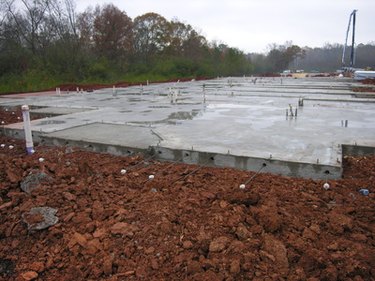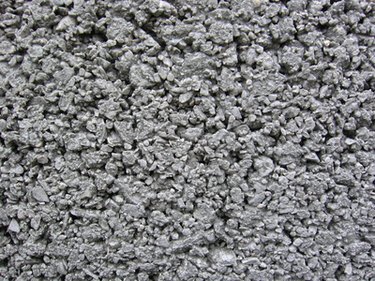Things You'll Need
Calculator or computer spreadsheet
Concrete data resources

The role of concrete has expanded beyond structural considerations to its capacity to store heat during periods of peak temperature and then to release it during off-peak hours. The use of concrete building materials allows power utilities to deal with peak loads during extreme conditions while preventing brownouts and lowering energy costs. According to the Portland Cement Association, heat capacity (HC) is the amount of heat energy required to raise the temperature of a mass 1 degree Fahrenheit. Calculating heat capacity is straightforward once the mass is determined.
Step 1
Calculate the mass of the concrete in question. Because concrete walls are defined in square feet of area and thickness, measure the number of square feet and multiply it by the wall's thickness. For example, a 1-foot-thick wall measuring 10 feet high by 10 feet wide will contain 100 cubic feet of concrete. The density of average concrete is 133 lbs. per cubic foot, so the wall's mass is 13,300 lbs.
Video of the Day
Step 2

Multiply the mass by the specific heat capacity of concrete, 0.2 BTU/lb/degree F. This yields 0.2 times 13,300 equals 2,660 BTUs to raise the temperature of the entire wall just 1 degree Fahrenheit.
Step 3

Adjust the base calculation for the specific dimensions of your application. For a 40-feet-long wall, the total BTUs per degree F would be 4 times 2,660 or 10,640 BTU/per degree F change. If the 40-foot wall is 2 feet thick, its mass would be 106,400 lbs., and the heat capacity would be 21,280 BTU/degree F change.
Step 4
Calculate the heat capacity change with a specified temperature change. If the 40-feet-long, 2-feet-thick wall was heated uniformly by 35 degrees F, the heat capacity would change by 35 degrees F times 21,280 BTU/degree F or 744,800 BTU. Heating that wall by 35 degrees by burning fuel oil would require about 5.4 gallons, assuming 100-percent efficiency.
Step 5
Adjust the calculation based on the type of concrete. Concrete with a high percentage of aggregate has a 10-percent lower specific heat capacity at about 0.18 BTU/lb/degree F. The 40-foot wall would contain about 744,800 times 0.9 or 670,320 BTU more for a 35-degree F rise in temperature. Similarly, concrete with only sand, but no stone, would have about 15 percent more BTUs at 0.23 BTU/lb/degree F or 744,800 times 1.15 or 856,520 BTUs more for a 35-degree F rise.
Step 6
Step 6 Analyze your entire concrete structure on the basis of square feet and thickness to know the net heat capacity change for a uniform change in temperature.
Tip
Set up spreadsheets to run calculations with a range of variables when building new concrete structures.
Warning
Structural considerations must be carefully considered when locating concrete thermal masses above ground or overhead.
Video of the Day
- Portland Cement Association/Concrete Thinker: Thermal Mass/Heat Capacity of Concrete
- Engineering Toolbox: Specific Heat (Capacity) of Solids
- The Schundler Co.: Shifting Peak Energy Loads with Concrete Masonry Construction
- Ed Boyden, PhD/MIT: Conversion Factors, Material Properties and Physical Constants
- Villanova University/Nick Pine: Two Views on Sunspace Design